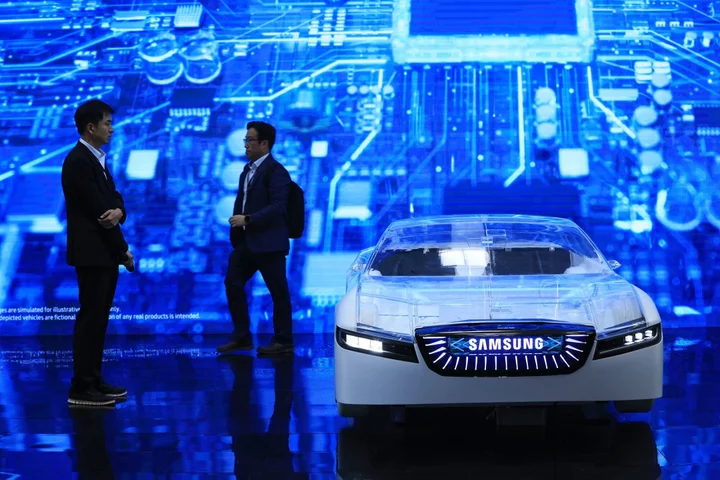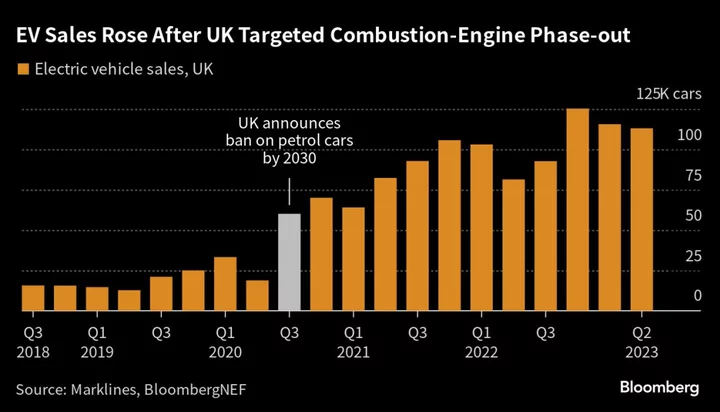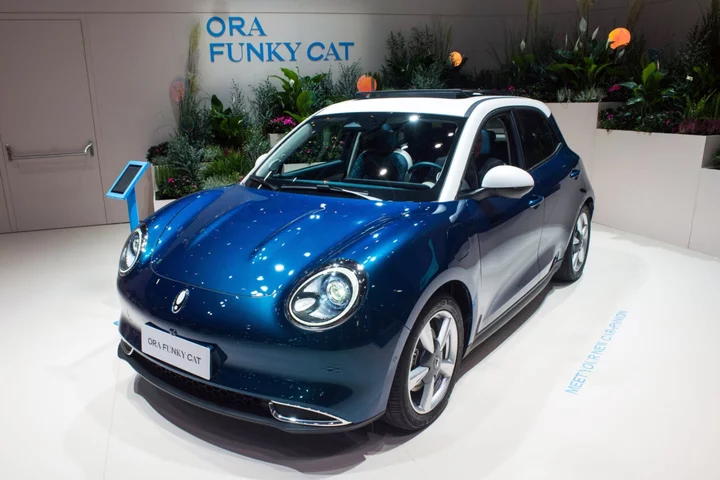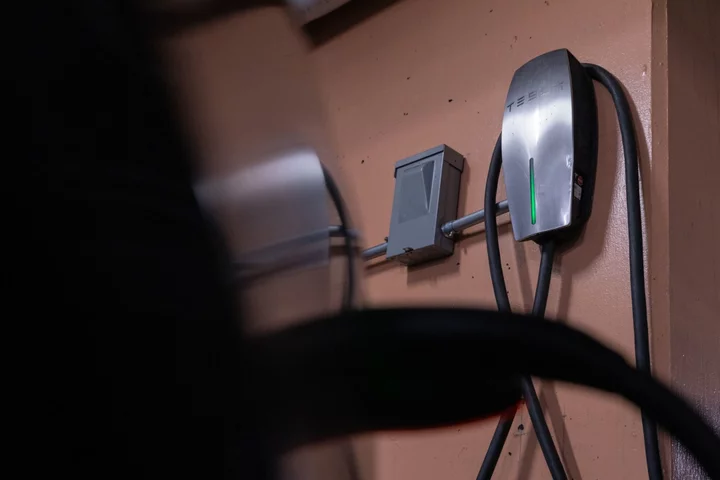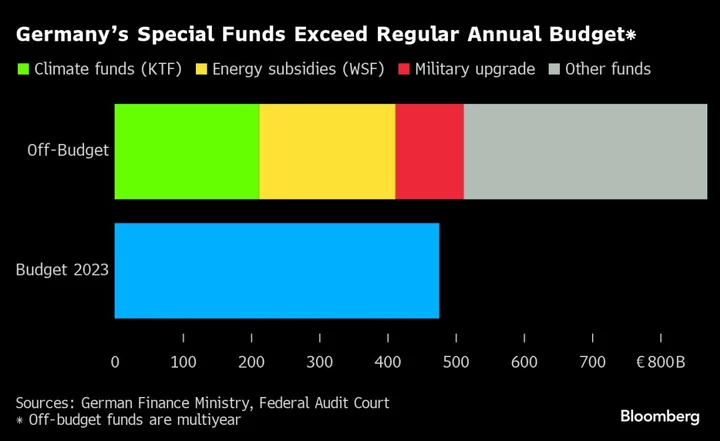The rise of electric cars is staggering.
Over the past decade, Teslas have gone from being the car of the uber rich to the car of the Uber driver. All of the major automakers are taking the plunge on EVs, which is driving down prices and expanding available options. Globally, this year will see more than 14 million electric cars sold, according to BloombergNEF, compared with just 700,000 in 2016. And some 23 countries have now passed a crucial EV tipping point — 5% of new-car sales — after which adoption picks up dramatically. In China, the biggest EV market, 38% of new-car sales were electric in August.
“We're off to the races on EV adoption in China now,” says Colin McKerracher, head of Advanced Transport at BloombergNEF, on this week’s episode of Zero.
Despite the tacit consensus on the future of drivetrains, obstacles remain for electric cars to meet their emissions-reduction potential. China’s dominance over the EV and battery supply chains has become a point of contention for other countries, as have China’s domestic subsidies for electric cars. In the long term, McKerracher says the growing competition will yield a race to the top in terms of quality and efficiency. In the short term, though, it may slow climate progress.
“All of this money and all of this capital and ingenuity is fundamentally a good thing for the transition,” he says. “But it might be a question of a step or two back to make two or three steps forward.”
McKerracher joined Akshat Rathi on this week’s Zero to discuss how the EV transition is tracking against climate goals, why China has succeeded where others haven’t and when we’ll finally see more electric cars on the road.
Listen to the full episode and learn more about Zero here. Subscribe on Apple, Spotify, and Google to stay on top of new episodes.
Our transcripts are generated by a combination of software and human editors, and may contain slight differences between the text and audio. Please confirm in audio before quoting in print.
Akshat Rathi 0:00
Welcome to Zero, I’m Akshat Rathi. This week: EVs everywhere all at once.
It wasn’t long ago that electric vehicles were seen as a novelty item that some eccentrics pursued despite the many problems: The range was too short, the charging too slow, the price too high. Now they are everywhere. Teslas have gone from being the car of the uber rich to the car of the Uber driver. And all the major manufacturers have been forced to take the plunge into making electric vehicles.
The growth is staggering. In 2016, just 700,000 electric cars were sold globally. This year it’ll be over 14 million. The charge is clearly led by China, but EVs are seeing a rise in popularity all across the world. That has left many analysts amazed. And yet, despite all this success, we’re still way off meeting climate targets.
Colin McKerracher 1:05
We're not on track. So even though it's gone really quickly, we're not on track for the net zero scenario. The net zero scenario is that pretty much for passenger car sales, you need to phase out combustion vehicle sales fully globally by around 2035.
Akshat Rathi 1:17
That’s Colin McKerracher, Head of Advanced Transport for BloombergNEF. If you want to get an understanding of everything that’s going on with electric vehicles worldwide and where the industry is going next, he’s the person to talk to. Every time I read one of his columns, I walk away feeling like I’ve learned something new. He recently wrote about how China has reached peak gasoline demand, how EV sales breached $1 trillion in total sales, and why EVs are winning because of consumers, not politicians.
Colin joins us on Zero today to share his thoughts on how we get electric cars on track to meet climate goals, why China has succeeded where others haven’t, and when we’ll finally see more electric cars than those burning fossil fuels. And I wanted to start by putting to bed a myth that’s persisted for too long.
Akshat Rathi 2:10
One debate which kind of is dying, but I feel like, if it is dying then maybe it's time to put the death nail in it. Do EVs, when you take the total emissions of making them and running them, cut carbon dioxide emissions relative to an internal combustion engine or not?
Colin McKerracher 2:27
Absolutely, unequivocally, yes.
Akshat Rathi 2:30
Even on a 100% coal powered grid?
Colin McKerracher 2:32
Yeah, if you have a 100% coal fired grid, of which there are very few in the world, then the benefits on a lifecycle basis are pretty marginal. It's sort of a 10-15% benefit over a new efficient internal-combustion-engine vehicle. But in most other places, it's a dramatic, dramatic reduction. So it might be 80%, 70%, depending on the country.
You can think of it another way in terms of payback. So making an EV battery and the components associated with it have a higher carbon footprint than making an internal combustion engine. In the US, with the current grid mix, you pay back that higher upfront CO2 burden in about a year and a half of driving. Now, in some cases, that's two years. In China, it's more like five or six years. But the point is that that vehicle will continue to get cleaner over its lifecycle as long as we can keep getting the power infrastructure and grid generation mix cleaner. And we're doing that. You've done many shows on solar and on renewables, that's happening, you're not going to derail that trend, there's going to be more and more renewables on the grid. And an internal combustion engine vehicle, when it rolls off the line, its emissions profile is locked in for the lifetime of the vehicle and slightly gets worse as the efficiency can degrade. Now, with an EV you aren't locking in the emissions, its emissions profile changes over time, and it will continue to get better. So there's a lot of ways you can make this look bad. You can say, ‘Oh, a vehicle only goes 100,000 kilometers (60,000 miles) in its lifetime.’ It doesn't; they go a lot more than that. You can take outdated studies on how much emissions are from making a battery. You can look at old data on grid emissions intensity factors for a country and assume they stay frozen for 15 years. But again, all those are just really bad methodological assumptions. And it really irks me. And it irks anybody who works on this stuff to see those things come up over and over again. Because it's actually not that complicated a calculation. If you use good current data on it, you come unequivocally to the conclusion that EVs have lower lifecycle CO2 emissions than comparable combustion cars today.
I think there's one other thing that's important to mention there, too. We're talking entirely about carbon here My view is that from a health point of view, and urban air quality point of view, you can probably justify doing this even totally separate from the CO2 benefits. And you can see that health benefit immediately. And that's just going to be more and more fuel for pushing this harder from a policy point of view, especially in cities.
Akshat Rathi 4:52
So let's start with a broad overview. What were you predicting when you first started the job as an EV analyst in 2015? And how have those predictions panned out?
Colin McKerracher 5:03
Yeah, so the main thing we were saying then was that battery prices had already come down about 60% over five years, from 2010 to 2015. And we were predicting that trajectory was going to continue, and then that was going to bring electrified transport into this sort of economically viable category in many, many different segments of transport. And that's effectively what has happened. The learning rate for lithium ion batteries has largely held up, the technology has gotten better, energy density has improved, cycle life has improved, safety has improved. But most importantly, cost has continued to come down. And that's really why we are where we are today. Policy has played a really big role, too, but it's an incredible technology success story on the lithium ion battery front. And that was our main prediction.
Akshat Rathi 5:44
Where have you been surprised in these eight years? If you looked at yourself, knowing what you knew in 2015 versus now, what in hindsight could you not have predicted or did you not predict?
Colin McKerracher 5:56
I think probably the biggest one is the speed at which China has gone all out for electric vehicles. So just as a reference point, in August 2023, 38% of vehicles sold in China had a plug. That's pretty remarkable for the world's largest auto market. And this is one of the tricky things about predicting major changes on a consumer-driven product is that you're looking primarily from a techno-economic perspective to start and thinking about when do these things become cost competitive, and all these different factors around policy and economics and technology. But ultimately, this is a consumer product. And eventually what happens is that consumer demand takes over. And that's essentially what happened in China. We thought that probably wouldn't happen until 2025 or 2026. Because we were looking at the technology and thinking, ‘Well, this is going to take a bit longer to get price competitive.’ But what has happened is that that happened several years sooner than we thought, and then adoption just went way up. I think we still probably got it better than most out there. But I think it's important to recognize that it has gone faster than we thought, particularly in China. In other regions, I think we’ve got it more accurate. In Europe, it's about where we thought it would be. In the US, we've actually overshot it a bit sometimes. But I think the biggest miss is probably just the speed at which this has happened in China. And we're still watching that, it continues to go. We're off to the races, if you will, on EV adoption in China now.
Akshat Rathi 7:09
And just to give a little bit of context on the numbers here. There were 3 million electric vehicles sold in 2020, 6 million in 2021, 10 million in 2022. And the forecast from BloombergNEF is 27 million in 2026. Now that's a global picture, and China dominates in this ecosystem. But before we get to China, what has all this EV-mania done to oil? Because that's where this transition is being driven, it is to try and drive down the consumption of oil. There is clearly growth in the market, but has it really dented oil demand?
Colin McKerracher 7:50
It's pretty modest, so far, if we're honest. We do this exercise every year where we look at all different types of vehicles, how much oil they’re displacing. And our estimate right now across all different types, and we talk about beyond cars, and we talk about buses and trucks and two and three wheelers. But it's about 1.5 million barrels a day. And that's against projection for global consumption this year of around 103 million barrels per day. So it's modest, but I would say it's growing quite quickly, and has the potential to start to dent oil demand in the latter half of this decade. I think the important thing to remember is there's this lag between new vehicle sales — of which EVs are now quite a rising share, about 20% in the most recent month of vehicles sold globally had a plug last month, which is quite remarkable.
Akshat Rathi 8:31
Wow.
Colin McKerracher 8:32
Yeah, that's the most recent data. So really, really remarkable numbers. But again, that's the share of new sales, it takes a long time for that to flow into the fleet, there's about 1.3 billion cars on the road globally, the vast majority of those still have an internal combustion engine, it's a little over 2% of those that are fully electric today.
Akshat Rathi 8:50
There's always this interest in knowing when the demand for oil will peak. And the business of predicting a peak is hard. And one of the peaks that you did get right is that in 2017, the number of internal combustion engine vehicles sold peaked.
Colin McKerracher 9:06
And that was uncomfortable to call at the time, I will say, because we made that call in 2018, and we could sort of see the cycle turning a little bit. And yeah, internal combustion engine vehicle sales are now down 20% from that, from that 2017 peak. By 2025, we think we're down 40%. And then there's just no real route back right? You gotta be a bit careful celebrating peaks. Because there have been some missed calls on this for 10 years later, something starts to rev up again.
Akshat Rathi 9:33
That's happening with coal right now.
Colin McKerracher 9:35
Yeah, exactly. Coal is probably the most famous one of those. But I'm reasonably confident we've got that right. I can't really see a route back to growth for the internal combustion engine. And actually the most interesting place to see that is the Shanghai Auto Show. You go to the Shanghai Auto Show and all of the design money, all of the newest gadgets, all of the coolest looking cars, all of them all of them are EVs, all the Chinese automakers, all of the money, all of the cool projects, all of the smartest people, they're working on the EVs, they're working on the electric platforms. The ICE platforms, internal combustion engine platforms, are sort of left to wither.
Akshat Rathi 10:07
In case you weren’t sure, ICE stands for the internal combustion engine.
Colin McKerracher 10:12
Even if they're still making up the majority of car sales today, it's clear that growth is what people want, not absolute market share. And growth is also what markets tend to reward, not absolute market share.
Akshat Rathi 10:32
So a lot of the time you're doing this, you're spending in front of big spreadsheets of data, but on a day to day basis, what do you drive? What have you driven that's been crazy? What are the sort of fun things you've done being the EV guru that you are?
Colin McKerracher 10:37
Yeah, I think sometimes people think we just get to go around and drive all these latest supercars or something, we really don't. I have driven most of the mass-produced models. Right now, my current vehicle is a Volkswagen ID.5, which I bought last summer.
Akshat Rathi 10:50
Happy with it?
Colin McKerracher 10:51
Yeah, happy with it, it's great. 500 kilometers range, does whatever it needs. Whenever we do road trips, the kids need to stop and pee long before we ever have to recharge the car so I've had no issues at all. I'm aware though that I have home charging in this apartment, which I think that gets at one of the challenges: In some places where apartments don't have home charging, there's still some challenges there to overcome in terms of getting people to be able to recharge easily, let's say
Akshat Rathi 11:15
China is the giant when it comes to EVs, but we should acknowledge you live in Oslo, which technically is the capital of EVs.
Colin McKerracher 11:21
Yeah, definitely, it's a very high percentage here, I look out the window and I can see all the new EVs. Whenever they hit the market, whether it's a Chinese one, an American one or a European or Japanese one, you see them on the road right away here in Oslo, which is fascinating. There's a huge amount of consumer choice and that's because it's a market that went early that built a lot of charging infrastructure. And where now 90% of sales are already plugins. This market is kind of done, essentially, we're now just waiting for the fleet to turn over.
Akshat Rathi 11:48
China is by far and away the biggest purchaser of EVs, the biggest maker of EVs. Last year, it accounted for 60% of all sales. Why has China been such a success story, and even more of a success story than you predicted it could be?
Colin McKerracher 12:06
I think it's been a combination of factors. And they've all come together quite well. The first one has been government policy support. So the government has been very clear from quite early on that it sees new energy vehicles, which is their term for fuel-cell, battery electric and plug-in hybrid, as the future. And they've supported different stages of policy to do that. So at the beginning, it was all about pushing government purchasing towards that, so all government fleet vehicles and that sort of thing. Then there was this other phase of pushing the automakers more strongly into it through its new energy vehicle credit system. And also city policies, which played a big role in making it harder for end-consumers to buy an internal-combustion engine. You need to get a license plate in a major Chinese city that usually involves a lottery or an auction system, which is kind of unheard of to people in North America, the idea that you might have to wait to get a license plate, even if you already have the money to buy a car. But that's how it works in a lot of the big Chinese cities because they've been concerned about congestion.
Akshat Rathi 12:58
You can't take our freedoms away in America, can you?
Colin McKerracher 13:01
Yes, or other places, too. I think if you told people in Europe that they had the money to buy a car, but they can't get a license plate for it, they might get pretty upset as well. So that has been a big part of that too, because EVs were allowed to go around that in the biggest cities and you could get a license plate right away, or at least on a shorter time frame, if you were putting an EV on the road. So China declared war on urban pollution. And one of the best things you can do to clean up urban air quality is to electrify vehicles. So places like Shenzhen, you go to them, they electrified the buses fully in 2018; all the taxis, a large portion of passenger vehicle fleet is now electric. It's pretty clean, and you notice the air, versus some of the other ones that are further behind, that the air quality is better. So that was a big part of that policy push that factored in both national, regional and local governments.
The other one is just that the Chinese automakers were never really globally competitive in the internal combustion engine vehicle market. And if you look at the biggest economies in the world — the US, Japan, Germany — all those other ones had an outsized domestic auto industry that exports to the world. And China didn't. And so they recognized that there's a window of opportunity there and a focus of industrial policy to keep that window open and jump through it. To leapfrog a little bit and therefore build out a lot of the supply chain necessary to do that. So the battery manufacturing capacity in China is huge. There's enough batteries manufactured in China this year to more than meet global EV demand and stationary storage demand, there's actually over capacity. So that supply chain build up was really important.
And then the last one is just that Chinese consumers tend to adopt new technologies faster than their counterparts in North America or Europe. And some of that is due to a younger average age of the buying population. But some of that, when it comes to cars I think, is because there's been this huge rise of the middle class in China, and they may not have the same expectations over many generations of exactly what a car trip might be, or what a car exactly should do. And you think about, if you grew up in North America, maybe you went for a road trip with your grandparents or your parents in college, and you have this very set idea of exactly what the car should do for you and what it should be. There's something in that as well, with a newly upwardly mobile Chinese middle class, that many of them are the first car buyers in their family. And I think that makes them a little more flexible to adopting new technologies. And that's certainly borne out in the data, this Chinese willingness to adopt new technologies probably faster and sooner than in other regions of the world.
Akshat Rathi 15:26
In my book, Climate Capitalism, I go through the story of Wan Gang, the Chinese science minister at the center of this concentrated period between 2009 and 2017 when China ended up spending, to one estimate — a conservative one — something like $60 billion on trying to build this industry. In that process, it has captured the battery supply chain. Batteries are at the heart of the electrification story. And we're starting to see a reaction from other regions to this dominance. Certainly, batteries have made regions like Europe and North America sit up and try to do something about it. How much do you think China's hold over the battery supply chain could be a hindrance for the kind of EV growth we need to be able to meet net-zero goals, which we still aren't on track for?
Colin McKerracher 16:21
Yeah, this is one of the most interesting tensions that's really come up in the last two years. There has been this goal of getting as much clean energy and clean technology deployed as possible, and that has hinged on cost reductions. And the cost reductions have been remarkable. But now we're entering an era where there are competing priorities. There is this other priority of where do the jobs go and balance of trade and R&D investment. Essentially industrial policy. And in many ways that is supportive of rapid decarbonization, but in other ways it can run counter to it.
What we're seeing is that we are going to see more and more regionalization of these markets, as countries or regions say, ‘Look, we want to capture more of the economic benefits and not just be consumers of these technologies.’ And in the near term, I think that might increase costs. It's very hard for me to say that a battery made in the US is going to be cost-competitive with a battery made in China, given the scale and inexperience of the Chinese manufacturing sector. But I think in the long term, this is sort of a race to the top. All of this money and all of this capital and ingenuity that's being invested in these regions to try and compete with China is fundamentally a good thing for the transition. But it might be a question of a step or two back to make two or three steps forward.
I often hear this argument that ‘It's done and China won and it's over.’ And I totally get where that's coming from. Our own data suggests if you look at the share of solar cell manufacturing, or the share of battery manufacturing, all the battery components and raw material refining… China absolutely dominates. But it is worth remembering that only a little over 2% of all cars on the road today are electric. There is a huge market still to play for. And we are seeing a lot of investment in the next generation of battery technology. So things like solid state batteries, next-generation anodes, sodium-ion batteries. That stuff is still up for grabs. It doesn't mean China doesn't have a head start. But I wouldn't underestimate the forces at play once you really get the innovation engines, particularly in the US, going. China has a dominant lead, but the story is not fully written yet.
Akshat Rathi 18:28
One place where these tensions are showing up is in Europe. In September, President Ursula von der Leyen announced a probe looking at whether cheap Chinese EVs are flooding the European market and distorting prices.
Ursula von der Leyen 18:42
Global markets are now flooded with cheaper Chinese electric cars, and their price is kept artificially low by huge state subsidies.
Akshat Rathi 18:54
The probe might sound counterintuitive: Surely cheap EVs are a good thing for meeting climate goals? Only about 10% of electric cars sold in Europe are from Chinese-owned companies. Most of the EVs are sold by European-owned companies. And yet the fear is that tens of millions of people employed by the auto industry will suffer if China continues to eat a bigger share of the market. That misses a crucial point. Many of the cars sold by European brands are already made outside of Europe. So is there anything to the probe beyond protecting a European car industry struggling to catch up?
Colin McKerracher 19:30
I think some of this might just be politics, it might be to show that, ‘Hey, we're there to ensure that European industry is successful.’ Some of those manufacturers are a little bit behind, and they are pushing politicians to say we need a grace period. ‘You need to help us with a grace period to catch up because we didn't take this as seriously as we should have. We're a bit flat-footed.’ And one consistent thing over the last 20 years is that a lot of automakers opposed the steady tightening of fuel-economy regulations; they always fought to water them down. And what that meant is that they didn't invest as much in electrification. In the European automakers' case, a lot of them invested heavily in diesel. But consumers do want to buy EVs and now they are, to be honest, behind compared to Tesla and the Chinese automakers.
Akshat Rathi 20:15
After the break: Can any other tech derail the success of electric vehicles, or are battery-powered cars here to stay?
Akshat Rathi 20:36
For passenger cars, are battery electrics the future? Like, we have this hydrogen fuel cell vehicle, we have this plug-in-hybrid situation going on for some time. But as you see it, is the future battery electric and nothing else?
Colin McKerracher 20:51
I think the future is electric and plug-in. On the hydrogen point, I think that's dead for passenger cars. Sales are falling, they fell last year. The only market that's really keeping it alive is South Korea, where the incentives are extremely generous. They're also extremely generous in California, tens of thousands of dollars available in incentives. And even then the numbers are very, very modest. Even if the passenger fuel cell vehicle fleet were to double every three years from now all the way up to 2040 — that's the most optimistic scenario I can come up with — they would still only be about 0.2% of the global vehicle fleet in 2040. So, irrelevant from an emissions-reduction point of view, irrelevant from a climate point of view. Where it's more interesting is within plug-in vehicles. So about 75% of all plug-in vehicles today are battery electrics, but there's still a decent number of plug-in hybrids sold.
Akshat Rathi 21:40
A plug-in hybrid is a car with an internal combustion engine and a battery pack that can be recharged with an external cable. The car will run on the battery pack until it's out of juice, and then switch to burning fossil fuels.
Colin McKerracher 21:50
There's still a decent number of plug-in hybrids sold. And the place where that's really interesting is China. So the plug-in hybrid market for a while was driven primarily by Europe, and it was a compliance market. So automakers had to meet certain CO2 targets for their vehicles and you saw this large number of questionable plug-in hybrids with very short ranges. They were able to sort of game the system a little bit, but people weren't driving them in electric mode all that often.
What's kind of different about what's happening in China is that there are plug-in hybrids coming out that are not purely designed for regulatory compliance. They're designed for consumers to actually use them in electric mode. They have ranges of 100-150 kilometers. And they're often being adopted in places where that public charging infrastructure isn't that great yet. I genuinely think that we are going to go all electric in the 2030s but I think the 2020s are still an interesting role for plug-in hybrids to play.
The other segment that I would just highlight there is that it's proving a little bit difficult to fully electrify the biggest pickup trucks in North America — the Chevy Silverado, the F-150. These are big trucks and you need a very big battery pack. It's challenging right now with the economics where they are today to make that fully cost competitive. Maybe Tesla can do it with a Cybertruck. But I would say actually in North America, it would be beneficial if somebody started offering a really good plug-in hybrid midsize pickup truck that could get 100-150 kilometers range in all electric mode and could be priced in that sort of $40,000 to $50,000 range instead of $60,000 to $70,000, which is where a lot of the big electric pickup trucks are coming in.
Akshat Rathi 23:23
Looking at the innovations and sticking to passenger cars. You talked a little bit about batteries and how getting faster charging batteries; higher energy density, which is essentially the same battery but longer range; and of course lower cost are all crucial. But what other innovations in the EV sector are you looking out for that would make this transition go faster?
Colin McKerracher 23:45
One of the ones that's kind of underappreciated is that we're just now at the stage where a lot of the large manufacturers have dedicated battery electric vehicle architectures, where they built their EVs from the ground up. And that just enables better performance, better integration, better efficiency. You can move to a higher voltage architecture, which allows for much faster charging as well. So you see some of these latest vehicles coming out capable of a 350 kilowatt charge, some even higher, which means that you get into that sort of 15 minutes to get from 20% to 80% of the battery. That's a pretty quick stop at that point. It's not gasoline, but by the time you stop and go in and get a coffee, that's enough.
Interestingly, we're also seeing — and this gets a bit away from the EV part of it — but we're seeing more and more of the automakers use their EVs as the place they put their newest other tech: their vehicle connectivity, their autonomous driving features, heads up displays. All these cool things, they're putting them in their EVs first as a way to make those vehicles more attractive. And then they will diffuse them out to their other vehicles. And that's actually quite a fascinating strategy, because then those become the cool, tech-rich vehicles where the newest stuff happens. And the people who maybe didn't care as much about the electric drivetrain, but want access to that tech, they're buying those ones because that's where you find the latest lane-keeping assist, or automatic emergency braking, or level three autonomy, all these newer features that are starting to come out. So I think that's actually quite an interesting trend to watch, too, is that more and more of that is being stuffed into those EVs.
Akshat Rathi 25:10
Will we ever see an EV that charges as quickly as it takes to fill up a petrol car?
Colin McKerracher 25:17
No, I don't think you will, and I don't think that's the right goal either. Even if you could from the battery point of view, and that would take a lot of engineering to do that, the grid connection you would need to do that for multiple vehicles at a time would be astronomical. And you would risk damaging the battery to do it in this sort of a-few-minutes timeframe. But again, I don't think that's what you need. If you look at the data on where people are charging, most people are still doing most of their charging at home. So we don't need to replicate the existing refueling infrastructure in the exact way it is because most of the energy delivered to the car is going to come when the car is stationary. I think you will see more vehicles moving toward the capability to accept a higher charge, but I don't think it goes up forever. There's diminishing returns on making a vehicle capable of something that the chargers and the grid themselves are not capable of.
Akshat Rathi 26:03
Now, you mentioned that big SUVs and these pickup trucks in the US are really hard to electrify, not because there is no technology to do it, but because of the amount of batteries that need to go in it and the price of batteries is still high. So should we just be pushing for smaller cars?
Colin McKerracher 26:20
Yes, I mean, unequivocally, yes. It's always been better from an environmental point of view to drive a smaller vehicle. That's still true in the EV world. Just because we switch to electric drivetrains doesn't mean that everyone, everywhere should drive the biggest vehicle they can. A small vehicle is still better. An EV is still better than a combustion vehicle but we should be pushing both for smaller, lighter vehicles and electric vehicles at the same time.
Akshat Rathi 26:42
The electric vehicle story from a car perspective has been going gangbusters. And yet we are still behind on net-zero goals. So what do we need to do to get the passenger car sector to get on track? Policy? Banning sales (of internal combustion vehicles)? What are the tools in the arsenal that need to be thrown at this?
Colin McKerracher 27:02
Yeah, so that's an important point that you make, we're not on track. Even though it's gone really quickly, we're not on track for the net-zero scenario. The net-zero scenario is that pretty much for passenger cars, you need to phase out combustion vehicle sales fully, globally, by around 2035. And even that requires some early retirement of vehicles in the 2040s to get some off the road. And that's just because vehicles last roughly 15 years. So if you say net-zero by 2050, net-zero vehicles only by then, you need to work back to that. So I think you do need a stronger policy push still. It's very encouraging to see things like the Inflation Reduction Act, which are putting significant dollars towards driving more EV adoption in the US. And also, federal funding for charging infrastructure in the US is really starting to flow now.
So whenever we talk about the scenarios for what happens in the future, it's important to say what policy does this assume? What we call our economic transition scenario assumes no new policy, because I'm not in the business of forecasting whether Trump or Biden are going to win the next election and what policy platforms they might roll out if they do. But policy really matters and what you can safely say is that in places where there is no supportive policy, there's very, very little EV adoption. And in places where there's a lot of policy, there's a lot of adoption. So you do still need a stronger policy push. I think you need a few more automakers to come off the fence a little bit more, particularly the Japanese ones. And also we shouldn't absolve them of responsibility. Many of them lobbied against, or sued the California government over the zero-emissions vehicle mandate in Toyota's case. So they're not blameless in that also.
I do still think there's a big role for continued R&D investment in the technologies that enable this, because a breakthrough on next-generation battery chemistry could make this all go faster. We're seeing a lot of rumblings right now in sodium-ion batteries. So far, it's looking like it's going in probably cheaper cars or two or three-wheeled vehicles. But a big advance in another battery chemistry could blow this wide open. And I think we shouldn't stop investing in that, because the route from laboratory and science through to engineering and manufacturing still takes some time. So I think that's another area where you should continue to see a big push.
Akshat Rathi 29:09
Do you think the success of electric cars distracts from bigger debates that we need to be having around encouraging less car use and more public transport use and whether governments are directing their subsidies — their subsidies which are necessary for this transition — in the right places today?
Colin McKerracher 29:28
This is a tricky question, and the longer I spend with data on global emissions from transport of all types, the more I'm sure that you need all of the above. So when you talk to the urbanist crowd, they say, ‘Look, EVs aren't the solution, it should all be active transport and public transport.’ When you talk to the pure car people, they're skeptical of those things. You need all of the above, you absolutely need more public transit, you need more active travel, you need more urban density so that people don't have to move around, you probably need congestion pricing, and you need over a billion electric vehicles. And you shouldn't avoid that. Policymakers should not avoid that conclusion. You need all of it, but you do need over a billion electric vehicles on the road. And that's just because we've left this pretty late. There's not a lot of time to get global emissions under control. And even in places where you have huge amounts of active transport — and again, this isn't to disparage those — but take the Netherlands. The Netherlands is probably the most famous example of a cycle-friendly country. It's got great infrastructure, it's got a great cycling culture, great supportive policy over many years. About 9% of all kilometers traveled are by bicycle and about 70% are by car. And the Netherlands is small, rich, densely populated, temperate, and again, has this culture of cycling. So that's got to be the upper bound for a place like the US. It's just not that easy to do that, to achieve that same level of cycling adoption in other countries. So yes, you need more active transport, you need all these things, but you do need a lot of electric vehicles as well.
Akshat Rathi 31:00
You're going to break Oscar Boyd’s heart, who’s the producer on Zero and is obsessed with biking.
Colin McKerracher 31:04
I should just say, that is how I get my kids around the city. I have a bicycle and a buggy. I take two kids, drop them off at nursery every day, that's how I get around. Big believer in active transport. It's just we need to be realistic about what each thing can contribute in terms of global CO2 emissions reductions.
Akshat Rathi 31:22
When will there be more electric vehicles on the road in the entire fleet than fossil fuel powered cars?
Colin McKerracher 31:28
When it comes to the passenger vehicle segment, again, because it takes a long time to turn over the fleet, even when new sales largely go electric. In our economic transition scenario, it's about 2041 before EVs are the majority of passenger vehicle cars on the road globally.
Akshat Rathi 31:42
We'll be old men by that time, but I'm going to hold you to it and come back to you in 2041 and be like how wrong were you?
Colin McKerracher 31:48
I'm happy to be proved wrong. I will say my desire to see urban air quality improved and to see rapid decarbonisation is much, much stronger than my desire to be right about any of this.
Akshat Rathi 32:08
I’ve always lived in cities so I don't really drive all that much. But I cannot stop thinking about electric vehicles for all the reasons Colin mentioned. They’re just a huge part of the energy transition and there’s so much new tech going into making these cars better and more efficient. Electric cars are really only half the EV story though, join us for a future episode of Zero where we’ll hear more from Colin about how other forms of transport are being electrified, the good bits and the ugly.
Next week my book Climate Capitalism will be coming out. It has two chapters exploring China’s EV revolution. One of which follows the career of Wan Gang, who was China’s Minister for Science and Technology during much of the early EV boom. If you’d like to learn more about that and other stories of climate action, check the show notes for a link where you can pre-order the book.
Thanks so much for listening to Zero. If you liked this episode, please take a moment to rate and review it. Subscribe on Apple podcasts or Spotify. Send it to a friend or someone with range anxiety. Get in touch at zeropod@bloomberg.net. Zero’s producer is Oscar Boyd and senior producer is Christine Driscoll. Our theme music is composed by Wonderly. Special thanks as always to Kira Bindrim. I’m Akshat Rathi, back next week.
Author: Oscar Boyd, Akshat Rathi and Christine Driscoll

